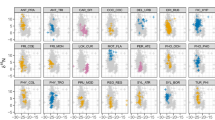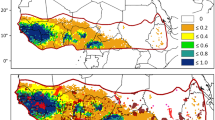Abstract
Understanding the links between breeding and wintering areas of migratory species has important ecological and conservation implications. Recently, stable isotope technology has been used to further our understanding. Stable isotope ratios vary geographically with a range of biogeochemical factors and isotope profiles in organisms reflect those in their food and environment. For inert tissues like feathers, isotope profiles reflect the environment in which they were formed. Following large-scale habitat destruction, the globally threatened aquatic warbler Acrocephalus paludicola has a fragmented breeding population across central Europe, largely in Belarus, Poland and Ukraine. The species’ sub-Saharan African wintering grounds have not yet been discovered, and this significantly hampers conservation efforts. Aquatic warblers grow their flight feathers on their wintering grounds, and we analysed stable isotope ratios (δ15N, δ13C, δD) in rectrices of adults from six main breeding sites (subpopulations) across Europe to determine whether different breeding subpopulations formed a single mixed population on the wintering grounds. δ15N varies considerably with dietary trophic level and environmental factors, and δD with the δD in rainfall; neither varied between aquatic warbler subpopulations. Uniform feather δ15N signatures suggest no major variation in dietary trophic level during feather formation. High variance and inter-annual differences in mean δD values hinder interpretation of these data. Significant differences in mean δ13C ratios existed between subpopulations. We discuss possible interpretations of this result, and consider differences in moulting latitude of different subpopulations to be the most parsimonious. δ13C in plants and animals decreases with latitude, along a steep gradient in sub-Saharan Africa. Birds from the most north-westerly breeding subpopulation (Karsibor, Poland) had significantly lower variance in δ13C and δ15N than birds from all other sites, suggesting either that birds from Karsibor are less geographically dispersed during moult, or moult in an area with less isotopic heterogeneity. Mean δ13C signatures from winter-grown feathers of different subpopulations were positively correlated with the latitude and longitude of breeding sites, suggesting a strong relationship between European breeding and African winter moulting latitudes. The use of stable isotopes provides novel insights into migratory connectivity and migration patterns in this little-known threatened species.


Similar content being viewed by others
References
Atienza JC, Pinilla J, Justribó JH (2001) Migration and conservation of the aquatic warbler Acrocephalus palidicola in Spain. Ardeola 48:197–208
AWCT–Aquatic Warbler Conservation Team (1999) World population, trends and conservation status of the aquatic warbler Acrocephalus paludicola. Vogelwelt 120:65–85
Bensch S, Hasselquist D, Hendenström A, Ottosson U (1991) Rapid moult among palearctic passerines in West Africa—an adaptation to the oncoming dry season? Ibis 133:47–52
BirdLife International (2000) Threatened birds of the world. Lynx Ediciones/BirdLife International, Barcelona and Cambridge
Both C, Visser ME (2001) Adjustment to climate change is constrained by arrival date in a long-distance migrant bird. Nature 411:296–298
Bowman WD, Hubick KT, von Caemmerer S, Farquhar GD (1989) Short term changes in leaf carbon isotope discrimination in salt and water-stressed C4grasses. Plant Physiol 90:162–166
By RA de (1990) Migration of aquatic warbler in western Europe. Dutch Bird 12:165–181
Cave AJ (1983) Purple heron survival and drought in tropical West Africa. Ardea 71:217–224
Chamberlain CP, Blum JD, Holmes RT, Feng X, Sherry TW, Graves GR (1997) The use of isotope tracers for identifying populations of migratory birds. Oecologia 109:132–141
Chamberlain CP, Bensch S, Feng X, Akesson S, Anderso T (2001) Stable isotopes examined across a migratory divide in Scandinavian willow warblers (Phylloscopus trochilus trochilus and Phylloscopus trochilus acredula) reflect their African winter quarters. Proc R Soc B 267:43–48
Cherel Y, Hobson KA, Weimerskirch H (2000) Using stable isotope analysis of feathers to distinguish moulting and breeding origins of seabirds. Oecologia 122:155–162
Cramp S (ed) (1992) The birds of the western Palearctic, vol 6. Oxford University Press, Oxford
Curry-Lindahl K (1981) Bird migration in Africa, vol. I. Academic, London
DeNiro MJ, Epstein S (1978) Influence of diet on the distribution of carbon isotopes in animals. Geochim Cosmochim Acta 42:495–506
Esler D (2000) Applying metapopulation theory to conservation of migratory birds. Conserv Biol 14:366–372
Hendenström A, Bensch S, Hasselquist D, Ottosson U. (1990) Observations of palearctic migrants rare to Ghana. Bull Br Ornithol Club 110:194–197
Hobson KA (1999a) Tracing origins and migration of wildlife using stable isotopes: a review. Oecologia 120:314–326
Hobson KA (1999b) Stable-carbon and nitrogen isotope ratios of songbird feathers grown in two terrestrial biomes: implications for evaluating trophic relationships and breeding origins. Condor 101:799–805
Hobson KA, Clarke RW (1992a) Assessing avian diets using stable isotopes. I. Turnover of carbon-13. Condor 94:181–188
Hobson KA, Clarke RW (1992b) Assessing avian diets using stable isotopes. II. Factors influencing diet-tissue fractionation. Condor 94:189–197
Hobson KA, Wassennar LI (1997) Linking breeding and wintering grounds of neotropical migrant songbirds using stable hydrogen isotopic analysis of feathers. Oecologia 109:142–148
Honza M, Literák I (1997) Spatial distribution of four Acrocephalus warblers in reedbeds during the post-breeding migration. Ring Migr 18:79–83
Hornibrook ERC, Longstaffe FJ, Fyfe WS (2000) Factors influencing stable isotope ratios in CH4 and CO2 within subenvironments of freshwater wetlands: implications for delta-signatures of emissions. Isot Environ Health Stud 36:151–176
IAEA (2001) GNIP maps and animations. International Atomic Energy Agency, Vienna. http://isohis.iaea.org
Kanyamibwa S, Schreider A, Pradel R, Lebreton JD (1990) Changes in adult annual survival rates in a western European population of the white stork Ciconia ciconia. Ibis 132:27–35
Kelly JF (2000) Stable isotopes of carbon and nitrogen in the study of avian and mammalian trophic ecology. Can J Zool 78:1–27
Kelly JF, Atudorei V, Sharp ZD, Finch DM (2002) Insights into Wilson’s warbler migration from analyses of hydrogen stable-isotope ratios. Oecologia 130:216–221
King JMB, Hutchinson JMC (2001) Site fidelity and recurrence of some migrant bird species in the Gambia. Ring Migr 20:292–302
Lake JL, McKinney RA, Osterman FA, Pruell RJ, Kiddon J, Ryba SA, Libby AD (2001) Stable nitrogen isotopes as indicators of anthropogenic activities in small freshwater systems. Can J Fish Aquat Sci 58:870–878
Lipp J, Trimborn P, Payer H-D (1998) Influence of relative humidity on the 13C content in bean plants (Vicia faber): a model experiment in exposure chambers. In: International Atomic Energy Agency proceedings series; isotope techniques in the study of environmental change. IAEA 14–18 April 1997, Vienna, pp 878–881
Madhavan S, Treichel I, O’Leary MH (1991) Effects of relative humidity on carbon isotope fractionation in plants. Botan Acta 104:292–294
Mizutani H, Fukuda, M, Kabaya, Y (1992) 13C and 15N enrichment factors of feathers of 11 species of adult birds. Ecology 73:1391–1395
Moreau RE (1972) The Palaearctic–African bird migration systems. Academic, London
Rice SK (2000) Variation in carbon isotope discrimination within and among sphagnum species in a temperate wetland. Oecologia 123:1–8
Romanek CS, Gaines KF, Bryan Jr AL, Brisbin Jr IL (2000) Foraging ecology of the endangered wood stork recorded in the stable isotope signature of feathers. Oecologia 125:584–594
Rubenstein DR, Chamberlain CP, Holmes R, Ayres MP, Waldbauer JR, Graves GR, Tuross NC (2002) Linking breeding and wintering ranges of a migratory songbird using stable isotopes. Science 295:1062–1065
Smith BN, Epstein S (1971) Two categories of 13C/12C ratios for higher plants. Plant Physiol 47:380–384
Smith BN, Oliver J, McMillan C (1976) Influence of carbon source, oxygen concentration, light intensity and temperature on 13C/12C ratios for higher plants. Bot Gaz 137:99–104
Still CJ, Berry JA, Collatz GJ, DeFries RS (2003) Global distribution of C3 and C4 vegetation: carbon cycle implications. Global Biogeochem Cycle 17:1006–1029
Svensson L (1984) Identification guide to European passerines, 3rd edn. Stockholm, British Trust for Ornithology, Thetford
Thompson DR, Furness RW (1995) Stable isotopes ratios of carbon and nitrogen in feathers indicate seasonal dietary shifts in northern fulmars. Auk 112:493–498
Wassennar LI, Hobson KA (2000) Stable carbon and hydrogen isotope ratios reveal breeding origins of red-winged blackbirds. Ecol Appl 10:911–916
Wassennar LI, Hobson KA (2001) A stable isotope approach to delineate geographical catchment areas of avian migration monitoring stations in North America. Environ Sci Technol 35:1845–1850
Webster MS, Marra PP, Haig SM, Bensch S, Holmes RT (2002) Links between worlds: unraveling migratory connectivity. Trends Ecol Evol 17:76–83
Acknowledgements
The authors would like to thank the Aquatic Warbler Conservation Team for their constant support and advice. Many thanks to Norbert Schaeffer and Neil Suits for advice and David Gibbons for comments on the manuscript.
Author information
Authors and Affiliations
Corresponding author
Rights and permissions
About this article
Cite this article
Pain, D.J., Green, R.E., Gieβing, B. et al. Using stable isotopes to investigate migratory connectivity of the globally threatened aquatic warbler Acrocephalus paludicola . Oecologia 138, 168–174 (2004). https://doi.org/10.1007/s00442-003-1416-z
Received:
Accepted:
Published:
Issue Date:
DOI: https://doi.org/10.1007/s00442-003-1416-z




